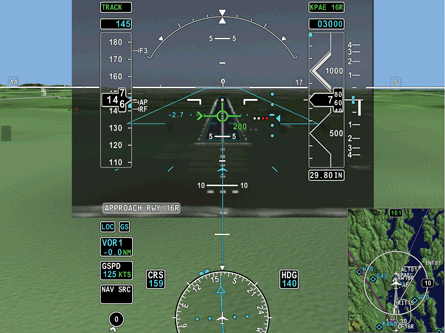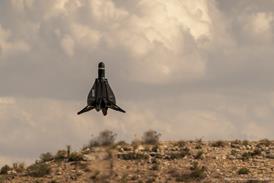Government and industry partners are making rapid progress in ushering in the era of "equivalent visual operations" for airlines and air taxis using hardware and software that gives pilots what the human eye cannot - a weather-free view of the world beyond the windscreen all the way to landing the aircraft and taxiing to the gate.
BUSINESS AVIATION LEAD
Business aviation has taken the early lead in deploying such technologies in the USA, with Gulfstream and Bombardier gaining "credit" for lower instrument landing minima under Part 91 general aviation rules using enhanced vision systems and head-up displays to augment eye contact with the runway environment in 2001 and 2005, respectively.
But changes in regulations in Europe and likely harmonisation with US Federal Aviation Administration rules will soon make the advances available to airline and charter cockpits as well.
 |
|---|
© HoneywellHoneywell is testing combined synthetic and enhanced vision concepts for head-down landing credit |
The European Aviation Safety Agency in August 2008 modified its rules (EU-Ops rule 1.430(h)) to allow appropriately trained crews and aircraft equipped with a certificated enhanced flight vision system (EFVS) to cut the required minimum visibility needed to start an instrument approach by one-third. Once on the approach, the pilots are then allowed to use the EFVS in lieu of natural vision down to a 100ft (30m) decision height for a category 1 approach, down from the typical 200ft decision height.
NATURAL VISION
Below 100ft, pilots have to use their natural vision to identify the runway environment to continue the approach to landing.
Unlike a similar FAA general aviation rule (FAR 91.175) however, the European rule applies to charter and airline operations in addition to general aviation (Part 91). In the USA, there remains an "approach ban" that does not allow airline (Part 121) and air taxi (Part 135) pilots to begin an approach if reported flight visibility is less than the minimum published for the approach.
Category 1 instrument approaches today require 0.5nm flight visibility or 1,800ft "runway visual range".
Reduced landing minima is the first phase in the broader push by the FAA and Europeans to eventually use enhanced flight visual systems all the way to touchdown. The technology could eventually boost capacity in instrument weather while allowing aviation authorities to save money by not having to install instrument landing systems and the associated lighting infrastructure at many airports and runways.
The past two years have seen a number of "walk before you run" steps in evolving equivalent visual operations (EVO), a key enabler for the US next generation air transport system (Nextgen) goal of increasing capacity and safety with less ground infrastructure. Based on the progress made in 2009, 2010 should prove to be a breakthrough year for Part 121 and Part 135 operators.
LEADING THE CHARGE
Cargo carrier FedEx Express and fractional business jet provider NetJets are leading the charge. Both have applied for exemptions to allow EVFS-trained and equipped crews at trained airlines and air taxis to begin a category 1 instrument approach with one-third lower visibility minimums, as in Europe, followed by a 100ft decision height.
The action is seen as a precursor to what will eventually be a modification of FAA rules that will allow other appropriately trained and equipped crews to do the same in the Part 121 and Part 135 sectors.
FedEx has FAA certification of a Honeywell/Elbit HUD and Kollsman infrared sensor combination that it is installing in its Boeing MD-10 and MD-11 fleet. NetJets has a fleet of Gulfstream G450 and G550 business jets equipped with an EFVS comprised of Honeywell-built HUDs and Kollsman sensors that already qualify for the reduced landing minimums under Part 91 rules.
Bombardier has also certificated a Thales HUD and CMC infrared sensor-based EFVS for its Global Express line.
Industry observers expect a thumbs up from the FAA on the request for exemptions this spring, as well as potentially some form of "credit" for lower landing minimums for aircraft and crews equipped with synthetic vision systems using head-down displays.
Furthering EVO, a joint RTCA and Eurocae panel that has been working to develop minimum standards for various EFVS and combined vision technologies (synthetic vision fused with enhanced vision), in June crafted a preliminary draft of an international rulemaking that would allow the use of EFVS down to the runway.
This year, the group will complete a set of technology agnostic minimum performance standards for how to do it safely.
Source: Flight International























